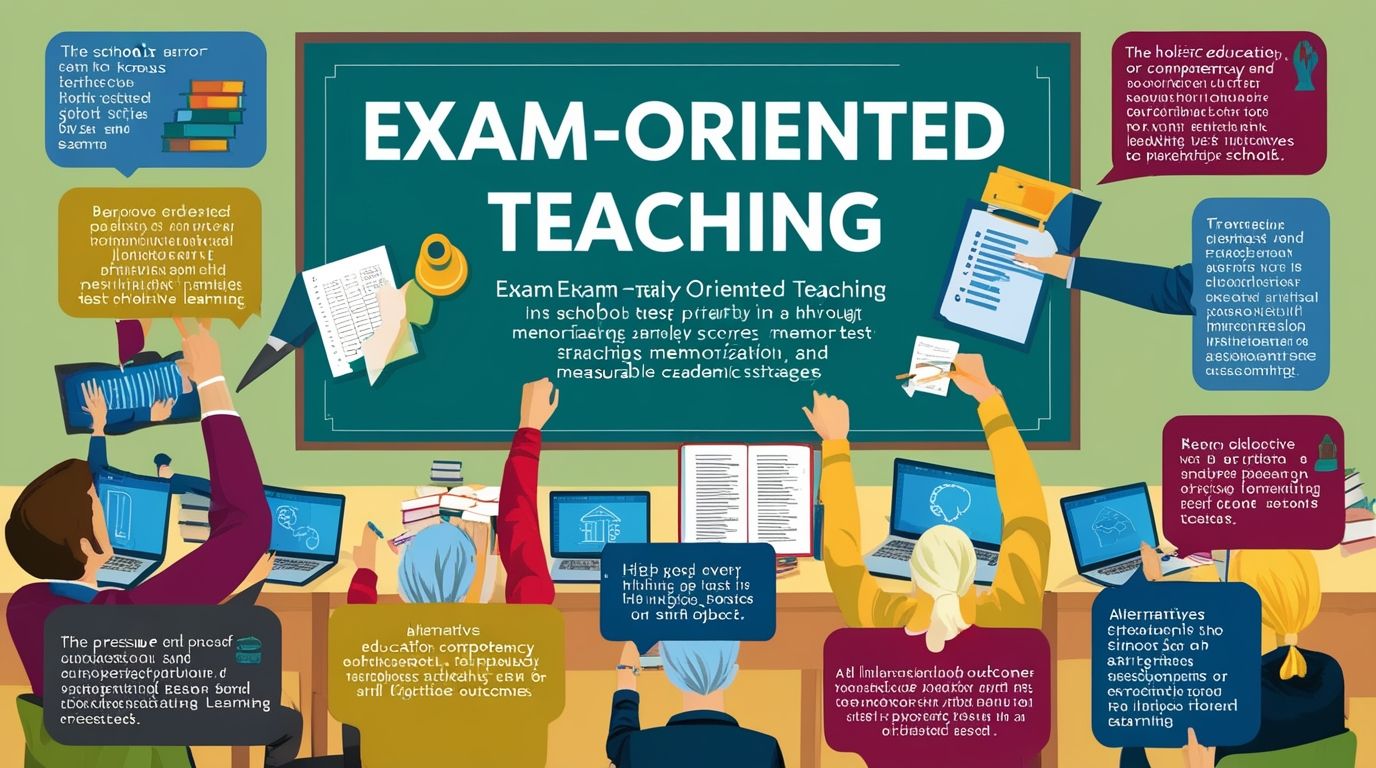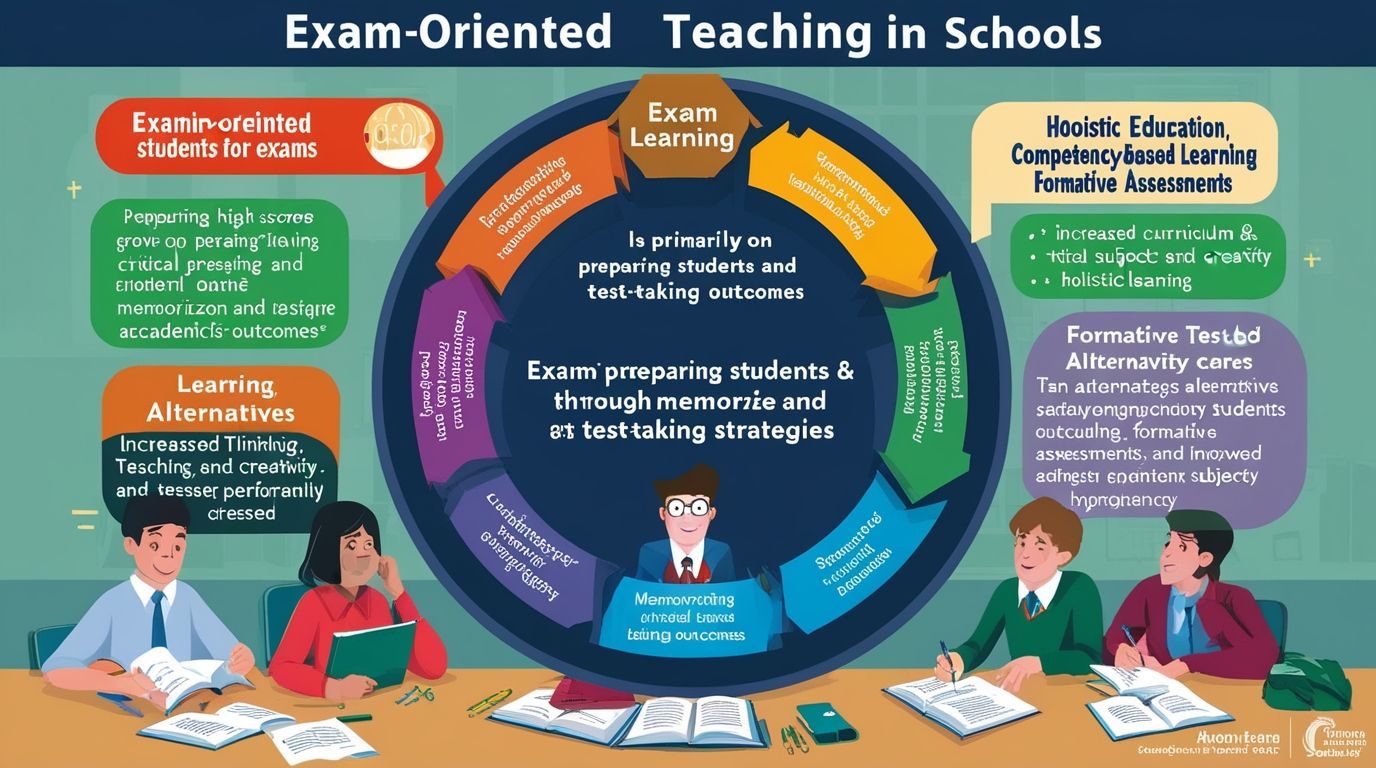Exam-Oriented Teaching in Schools, Exam-oriented teaching is a prevalent approach in educational systems worldwide, where the primary focus is on preparing students for exams. This method emphasizes mastering test-taking skills, memorizing information, and achieving high scores, often at the expense of holistic learning. While exam-oriented teaching has some advantages, such as providing measurable outcomes and motivating students to achieve specific academic goals, it also has significant drawbacks. These include stifling creativity, limiting critical thinking, and failing to address the broader educational needs of students. This article explores the nature of exam-oriented teaching, its implications on education, and potential alternatives.
The Nature of Exam-Oriented Teaching
Exam-oriented teaching prioritizes the content and skills needed to excel in standardized tests or school examinations. This method often involves repetitive drills, practice tests, and teaching to the test, where educators focus on likely exam questions and exam formats. In many cases, the curriculum designed to meet the requirements of standardized tests, which can lead to a narrowed educational experience.
This approach deeply rooted in the desire for measurable outcomes, which often used to evaluate the effectiveness of teachers and schools. Governments, educational institutions, and parents view exam results as indicators of academic success and future potential. Consequently, schools incentivized to focus on exam results to improve their rankings and reputation, making exam-oriented teaching a widely adopted strategy.
Implications of Exam-Oriented Teaching
- Limited Critical Thinking and CreativityOne of the significant drawbacks of exam-oriented teaching is the reduction in opportunities for students to develop critical thinking and creativity. The emphasis on rote memorization and repetitive learning techniques does not encourage students to explore concepts deeply or think independently. Students often learn to memorize information for exams rather than understand and apply knowledge in various contexts. This focus on memorization can undermine the development of higher-order thinking skills, such as analysis, synthesis, and evaluation, which are essential for problem-solving and innovation.
- Increased Stress and AnxietyThe pressure to perform well in exams can lead to heightened stress and anxiety among students. The fear of failure, coupled with high expectations from parents and teachers, can create a stressful learning environment. Students may experience burnout, reduced motivation, and a sense of inadequacy if they do not achieve the desired scores. This pressure can have long-term effects on students’ mental health, potentially leading to issues like anxiety disorders, depression, and a negative attitude towards learning.
Implications of Exam-Oriented Teaching
- Narrowed Curriculum and Learning ExperienceExam-oriented teaching often results in a narrowed curriculum that prioritizes subjects and topics likely to appear on tests. Subjects that are not directly tested, such as arts, music, and physical education, may receive less attention or neglected altogether. This limited focus can result in a diminished educational experience, where students miss out on opportunities to explore diverse interests and develop a well-rounded skill set. Additionally, the narrowed curriculum may overlook the importance of life skills, social-emotional learning, and other non-academic competencies essential for personal and professional success.
- Impact on Teaching MethodsTeachers in exam-oriented systems may feel compelled to adopt teaching methods that prioritize test preparation over meaningful learning experiences. This approach can limit the use of innovative and interactive teaching strategies, such as project-based learning, group discussions, and hands-on activities, which are known to enhance engagement and deeper understanding. Instead, teachers may rely heavily on lectures, worksheets, and practice tests, which can result in a monotonous and disengaging classroom environment. The emphasis on exam results can also discourage teachers from addressing individual learning needs, as the focus shifts to achieving uniform outcomes rather than catering to diverse learning styles and paces.

Alternatives to Exam-Oriented Teaching
- Holistic EducationHolistic education aims to develop the whole person by addressing the intellectual, emotional, social, and physical aspects of learning. This approach encourages a more balanced and student-centered learning experience, where students are empowered to explore their interests, develop critical thinking skills, and learn at their own pace. Holistic education often incorporates a variety of teaching methods, including experiential learning, project-based activities, and collaborative learning, which can foster a deeper understanding of subjects and a love for learning beyond exams.
- Competency-Based LearningCompetency-based learning shifts the focus from test scores to the mastery of specific skills and competencies. In this approach, students progress through the curriculum at their own pace, advancing only when they demonstrate a thorough understanding of the material. Competency-based learning emphasizes practical application, critical thinking, and problem-solving skills, which are essential for success in real-world scenarios. This approach allows for personalized learning experiences, where students receive targeted support and feedback to help them master each competency.
Alternatives to Exam-Oriented Teaching
- Formative AssessmentFormative assessment involves ongoing evaluation of student learning through various methods, such as quizzes, class discussions, projects, and peer feedback. Unlike traditional exams, formative assessments are designed to provide immediate feedback to both students and teachers, allowing them to identify areas of improvement and adjust their learning strategies accordingly. This approach encourages a growth mindset, where mistakes are viewed as opportunities for learning rather than failures. Formative assessments can also reduce the pressure associated with high-stakes exams, as students are assessed continuously throughout their learning journey.
- Integration of Technology in EducationTechnology can play a significant role in moving away from exam-oriented teaching by providing diverse and interactive learning experiences. Digital tools and platforms, such as educational apps, virtual simulations, and online collaborative projects, can enhance student engagement and facilitate personalized learning. Technology also allows for innovative assessment methods, such as digital portfolios, self-assessments, and interactive quizzes, which can provide a more comprehensive picture of student learning beyond traditional exams.
Balancing Exam Preparation with Broader Learning Goals
While exams will likely remain a part of educational systems, it is essential to strike a balance between exam preparation and broader learning goals. Educators can achieve this balance by incorporating elements of holistic and competency-based learning into their teaching practices, even within an exam-oriented framework. For example, teachers can integrate project-based learning and critical thinking exercises alongside test preparation activities to provide a more well-rounded educational experience. Additionally, schools can offer enrichment programs, such as arts, sports, and extracurricular activities, to complement academic learning and support the development of a wide range of skills.
Conclusion
Exam-oriented teaching, while effective in achieving specific academic outcomes, has significant limitations that can hinder the overall development of students. The focus on memorization and test performance can stifle creativity, increase stress, and narrow the curriculum, leaving students unprepared for the complexities of the real world. To address these challenges, educators and policymakers must explore alternative approaches that prioritize holistic learning, critical thinking, and the development of a broad range of skills. By balancing exam preparation with broader educational goals, schools can better prepare students for success in both their academic and personal lives.
References
- Biggs, J. B., & Tang, C. S. (2011). Teaching for Quality Learning at University. McGraw-Hill Education.
- Shepard, L. A. (2000). The Role of Assessment in a Learning Culture. Educational Researcher, 29(7), 4-14.
- Zhao, Y. (2016). Who’s Afraid of the Big Bad Dragon? Why China Has the Best (and Worst) Education System in the World. Jossey-Bass.

21 thoughts on “Exam-Oriented Teaching in Schools”
Comments are closed.